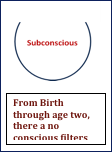To understand how you ended up with program that make no sense to you and are not serving you very well, it helps to understand the four states of mind.
BETA
As adults, we are in the beta state for most of our waking hours. Our brain radiates these waves (13 cycles per second, often greatly higher) when we are thinking, reasoning or engaging in problem solving. That was not the case when we were children.
ALPHA
 As adults, we are in naturally in the alpha state about 20% of the time. As children, between the ages of 3 and 7, we were in the alpha state about 90% of the time, which is one of the reasons why you have programs and patterns that are not serving you well as an adult. In the alpha state our brain waves cycle between 8 and 13 cycles per second. It is here that the door between our conscious and subconscious mind is opened. Moving into this state as an adult makes it easier to access the memories and storage of new information so we can update it. As a child, without the filters of logic to protect us, this state leaves us wide open to any suggestion. We take things literally that were not intended that way and everything that gets our attention gets programmed in.
As adults, we are in naturally in the alpha state about 20% of the time. As children, between the ages of 3 and 7, we were in the alpha state about 90% of the time, which is one of the reasons why you have programs and patterns that are not serving you well as an adult. In the alpha state our brain waves cycle between 8 and 13 cycles per second. It is here that the door between our conscious and subconscious mind is opened. Moving into this state as an adult makes it easier to access the memories and storage of new information so we can update it. As a child, without the filters of logic to protect us, this state leaves us wide open to any suggestion. We take things literally that were not intended that way and everything that gets our attention gets programmed in.
Statements as innocently made as “You can’t do that. You’re too little. ” which may have been an accurate assessment from a parent when we were 3, become a statement of fact without logical filters and now we have a program that will get triggered again and again throughout life until we purposefully change it. Then every time we find ourselves in a similar situation, even as a perfectly capable adult, the program activates and tells us “You can’t do that. You’re too little. ” So we don’t do something we are, in fact, perfectly capable of doing.
THETA
Below the two conscious states are theta (between 4 to 8 cycles per second and delta. Theta is a deep trance state. In adulthood, it is the REM (Rapid Eye Movement) or dream state or in waking, a deep reverie of trance state. When we are just going to sleep but not quite there yet, or just awakening but not yet fully awake, we are either in alpha or theta. Except in passing through on the way to sleep, adults rarely enter this state while awake. It is mostly utilized in adults in the sleeping dream state. That is not true of young children. From birth through age two children are in this state about 60% of the time, which means they are frequently in a deep trance state and very open to suggestion.
At alpha and theta, the two states children are in most of the time, our words have enormous power. Combine adamantly spoken words with an emotion or physical pain and you have the makings of a subconscious program.
Imagine the number of times you were scolded or punished for doing something (or not doing something) someone thought you should. Imagine the number of words and phrases that made their way into your unfiltered subconscious mind and took root there. Is it any wonder that you seem to sabotage yourself at times?
The reality is, there is no such thing as self-sabotage. What we see as self-sabotage is really a conflict between conscious desires and subconscious programs. The programs are never there to sabotage you however. They are there to protect your physical and conceptual bodies. Unfortunately, the conceptual body was formed for the most part before you reached the age of reason (around age 8) so your conceptual self is largely unreasonable.
DELTA
Delta is a very slow rhythm (below four cycles per second) which is a deep sleep state. Here we are totally unconsciousness so no external programming occurs here so far as we know. Some, usually people selling subliminal programs, suggestion that because the subconscious mind never sleeps, we are still suggestible in the Delta state. There is little, if any, valid evidence to support this. Any suggestibility during sleep likely occurs in theta.
The Six Functions of the Subconscious Mind
The Subconscious mind is:
- A memory bank that stores information like the hard drive of a computer
- A system that regulates involuntary functions, such as beating the heart, circulating the blood, regulating the endocrine system, thinking, etc.
- The generator of emotions
- The creator of imagination
- The central control system for patterns or habits
- The dynamo that directs energy and drives motivation
Next: Imagination